Expression cloning of TMEM16A as a calcium-activated chloride channel subunit
- PMID: 18805094
- PMCID: PMC2651354
- DOI: 10.1016/j.cell.2008.09.003
Expression cloning of TMEM16A as a calcium-activated chloride channel subunit
Abstract
Calcium-activated chloride channels (CaCCs) are major regulators of sensory transduction, epithelial secretion, and smooth muscle contraction. Other crucial roles of CaCCs include action potential generation in Characean algae and prevention of polyspermia in frog egg membrane. None of the known molecular candidates share properties characteristic of most CaCCs in native cells. Using Axolotl oocytes as an expression system, we have identified TMEM16A as the Xenopus oocyte CaCC. The TMEM16 family of "transmembrane proteins with unknown function" is conserved among eukaryotes, with family members linked to tracheomalacia (mouse TMEM16A), gnathodiaphyseal dysplasia (human TMEM16E), aberrant X segregation (a Drosophila TMEM16 family member), and increased sodium tolerance (yeast TMEM16). Moreover, mouse TMEM16A and TMEM16B yield CaCCs in Axolotl oocytes and mammalian HEK293 cells and recapitulate the broad CaCC expression. The identification of this new family of ion channels may help the development of CaCC modulators for treating diseases including hypertension and cystic fibrosis.
Figures






References
-
- Anderson MP, Sheppard DN, Berger HA, Welsh MJ. Chloride channels in the apical membrane of normal and cystic fibrosis airway and intestinal epithelia. Am. J. Physiol. 1992;263:L1–L14. - PubMed
-
- Arreola J, Melvin JE, Begenisich T. Inhibition of Ca(2+)-dependent Cl−channels from secretory epithelial cells by low internal pH. The Journal of membrane biology. 1995;147:95–104. - PubMed
Publication types
MeSH terms
Substances
Associated data
- Actions
Grants and funding
LinkOut - more resources
Full Text Sources
Other Literature Sources
Molecular Biology Databases

